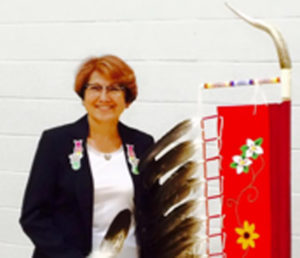Aamjiwnaang approves its Chi’Naaknigewin

By Rick Garrick
AAMJIWNAANG FIRST NATION—Aamjiwnaang has approved its Chi’Naaknigewin of Aamjiwnaang constitution with 140 of 158 voters casting a ballot in favour, 13 voters casting a ballot against, and five ballots rejected.
“We have a constitution now,” says Aamjiwnaang Chief Joanne Rogers on the day after the Oct. 27 constitution vote. “I haven’t been out in the community, but the members I have seen in the office here are very supportive and that is a good sign.”
Rogers says the band formed a constitution committee to provide information about the constitution to community members.
“They attended a lot of groups — they had group sessions with the seniors, with the youth,” Rogers says. “It’s just like any other [issue] that we bring to the community. As long as they are aware and the information is communicated to them and they understand, then their participation is great. It’s just the communication part — we’ve got to get out there and we’ve got to talk with them. And that’s what we did with respect to the constitution. We were really happy with the people that came out.”
Rogers says the community’s high school and post-secondary students were also involved with the constitution process.
“Our youth were involved in this process as well,” Rogers says. “We had post-secondary students at the community level at the meetings also take part in encouraging members to get out and vote.”
The constitution is posted on the community’s website. It features nine chapters, including General Provisions, Founding Provisions, Chi’Naaknigewin, Jurisdiction, Aamjiwnaang Government, Wiidookdaamin Gimaagumig Anishinabeg, Financial Administration, Aamjiwnaang Administration, and Constitutional Amendment.
Rogers says the community plans to focus on election laws and education now that their constitution has been ratified.
“We just had [Chief and Council] elections this past year,” Rogers says. “A lot of people are wanting our own election laws. But our focus right now is on education and getting ready for the [Anishinabek Education System].”
Rogers says the community has to work on getting community members out for the Say Yes to AES Ratification Vote, which takes place from Nov. 28 to Dec. 2.
“We’re going to have to get out to the community,” Rogers says. “And we are going to have to tell them a lot [of information] so they understand about the AES, just like we did [for the constitution].”
The Anishinabek Nation has been running a Say Yes to AES campaign since November 2015. Information about the proposed agreement with Canada, fiscal arrangements and the Anishinabek Education System can be found online.
Rogers says that the community is looking for more control over education through the AES.
“We get to determine what programs get to be funded,” Rogers says. “We are going to have more Aboriginal programs. And [our students] are going to better understand our ancestors and know who they are, get back to the traditional teachings, learn about the Seven Grandfather teachings. They’re going to be able to get more of that and understand it.”
For the AES to be approved at the First Nation level, a minimum of 25 per cent of eligible voters must vote yes. Those voting yes must also represent the majority of voters.
At least 12 First Nations are required to approve the agreements to meet the ratification requirements.


